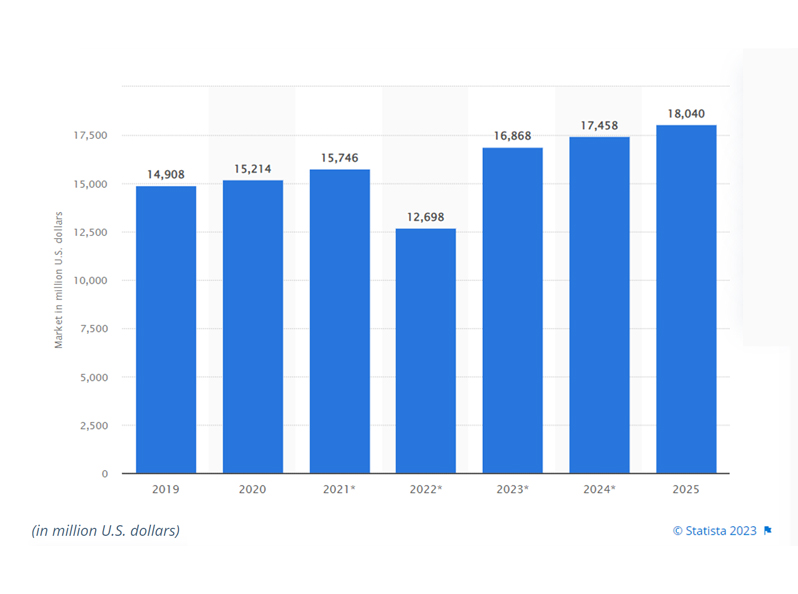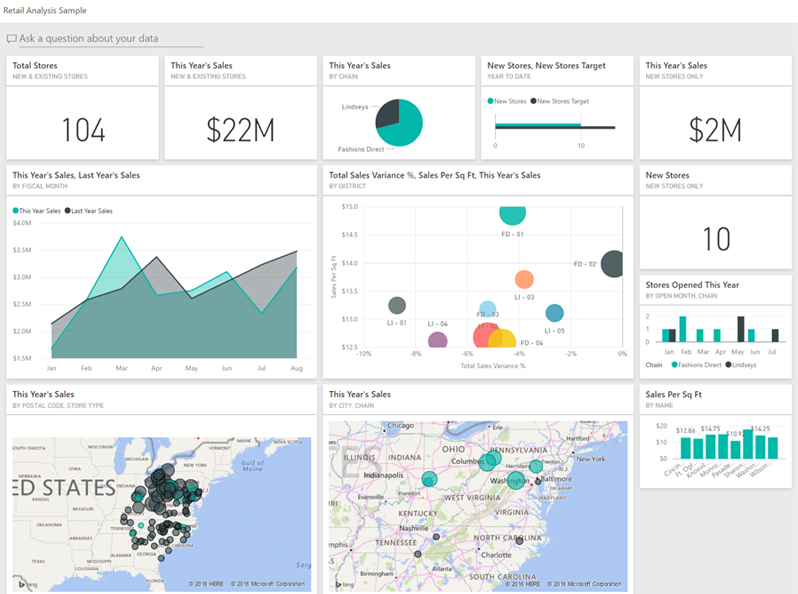Overview of BI in Retail Industry
The global retail market size reached over USD 23 trillion in 2020 and is anticipated to increase at a healthy rate between 2023 and 2028. As one of the most data-driven businesses, retail companies are increasingly turning to Business Intelligence to capitalize on possibilities. Business intelligence (BI) technologies assist retailers in organizing, analyzing, and contextualizing business data. And with reports, performance metrics, and corporate trends, it allows for informed decision making in the present. In addition, BI enables retailers to estimate sales, assess market potential, and get a greater understanding of consumers.

Source: Statista
In the next few years, the global market for business intelligence and analytics software solutions is expected to grow from 15.2 billion U.S. dollars in 2020 to more than 18 billion in 2025; it goes without saying that BI can boost the retail sector specifically.
Benefits of BI in Retail
Business Intelligence allows organizations to grasp large amount of data about sales to market trends, customer behavior & needs, and more. The data analyzed with the help of BI tools helps businesses to connect with its customers.
Here are the few key benefits of business intelligence in the retail industry:
• In-depth comprehension of patron’s behavior: Customer satisfaction is the cornerstone to every business's success. It offers value to the company, aids in customer retention, minimizes staff turnover, and enhances brand loyalty. Business Intelligence can assist merchants in identifying their customer, desires, and behaviors. This data may be used to enhance customer service and create more successful marketing initiatives.
• Enhanced Inventory Management: Inventory control is the foundation of every successful retail operation. It includes the procurement, storage, and sale of raw materials and completed commodities. Any retail organization with inventory has a number of inventory challenges. From ineffective monitoring to overstocking challenges, inventory management can be challenging for merchants. BI and data analytics solution, however, can aid in inventory management and eliminate the majority of stock-related issues shops experience.
• Store Floor Plan Optimization: One of the primary reasons retailers use BI is to create a floor layout that would entice customers to spend significant time shopping. Businesses should choose a layout that enables clients to shop without hassle. With the aid of business intelligence tools, they may examine many data sets such as the number of stops, the length of each visit, and the items purchased and propose a layout that will make it easier for customers to locate what they're looking for.
• Improved Merchandising: Merchandising is the most crucial aspect of a retailer's operation and one in which merchants are starting to fully harness the advantages of business intelligence. The initial distribution of products across channels and outlets is more precise when the analysis of previous success is paired with plans and estimates of future consumer behavior. Based on client demand patterns, assortment and size optimization ensures that the relevant assortments, sizes, and case-pack distributions are provided to the correct retailers. Pre-season and in-season pricing, promotion, and markdown optimization ensures that goods are priced for maximum profitability.
• Efficacious marketing: With the proliferation of social media tools and marketing platforms, the marketing business has become more data-driven. To get the greatest results from a marketing plan, however, firms must have a system in place that can give relevant insights and evaluate data on the purchasing behavior of customers. Consequently, BI tools come into play. They increase the effectiveness of a company's marketing initiatives.
Core Functionality of Retail BI solution
• Data Consolidation
• Data Analysis and Reporting
• Data Representation
• Inventory Management
• Assortment Management
• Price Optimization
• Customer Analytics
Emergence of Retail Business Intelligence Ecosystem
Due to the emergence of channels offering similar choices and competitive pricing, retailers must sharpen their customer-centric strategy to maintain brand loyalty. Retailers need to understand behavior, trends, and competition and leverage insights at the right time. ebizframeBI helps retailers run more effective loyalty programs and make better business decisions.
Outcomes possible with Loyalty Analytics for Retailers:
1) Improved customer experience - Create customized loyalty programs across segments and geographies to improve customer engagement and end-to-end experience.
2) Higher LTV and referrals- Increase customer lifetime value (LTV), customer satisfaction, and brand endorsement by implementing rewards-based recommendation programs
3) Better ROI on transactions- Drive better customer engagement directed through Loyalty Programs for improved purchases at higher frequencies and increased spend per transaction
4) Increase in brand stickiness- Improve customer retention and brand stickiness by leveraging insights across channels In order to increase sales revenue and market share, retailers need to understand complex customer behavior across touchpoints, relationships among products, and their visibility inside stores, as well as various other digital selling channels. Data-driven predictions on buying patterns are essential for increasing sales across locations and products. ebizframeBI helps retailers make strategic decisions based on the right association/mix.
The method used to achieve the same:
Market Basket Analysis: By understanding customer purchasing patterns, retailers can increase sales using market basket analysis. In this process, large data sets, such as purchase histories, are analyzed to find product groupings and products that are likely to be purchased together. Possible outcomes with market basket analytics:
• Right store identification- Determine which store is best for driving footfalls, running personalized promotions, boosting sales, and maximizing profits.
• Improved selling opportunities- The ability to predict sales at the right time and place to the right customer and to drive campaigns to increase cross-selling and upselling.
• Focused market strategies- Hyper-targeting the market by creating customer segments based on their buying behavior to improve ROI.
• Better SKU placements- Strategic placement of a product SKU next to the associated popular selling product SKUs to improve visibility and sales through products ‘bundling.’
Transforming raw data into actionable insights to aid in decision-making is facilitated by a technology-driven approach. There are a variety of approaches, but analytics is often used to spot patterns. This is particularly helpful when using real-time data technologies to increase consumer interaction. As a result, sales teams may better understand their clients' backgrounds, routines, and potential areas of interest. It goes without saying that the more you learn about your clients, the more effectively you can engage with them and meet their needs.

The following are the few ways in which retailers can improve BI capability by utilizing the various solutions suited to their needs:
• Dashboards and visualization
• Data Mining
• Predictive Analysis
• Prescriptive Analysis
• Text Analytics
Case Study based on the effects of BI in Retail Industries
One of the biggest suppliers of electronic appliances in West Africa. With over 15 years in the consumer electronics sector, it is geared towards bringing the latest technology to your doorsteps, bringing happiness into the lives of individuals, homes, offices, and the hospitality sector in West Africa. The company was using the traditional ERP system till 2019. The company implemented ebizframeBI in 2020, which changed its business model. The business transformation towards better performance. Although revenue fell in Apr-20 rest of the months, have performed much better than the previous year.
Similarly, with continuous use of BI and having benefited from it, they further capitalized on the tool's capabilities and decided to completely automate management MIS.
FAQ’s
• What is Retail Business Intelligence?
The only objective of a business intelligence system is to assist organizations in tracking operational efficiency, controlling budgets and managing expenditures in real-time and eventually making more informed business choices. By integrating several ERP systems to BI tools, you may get visual data in real-time on mobile, desktop, and tablet devices.
• What is the objective of Business Intelligence?
The only objective of a business intelligence system is to assist organizations in tracking operational efficiency, controlling budgets and managing expenditures in real-time and eventually making more informed business choices. By integrating several ERP systems to BI tools, you may get visual data in real-time on mobile, desktop, and tablet devices.
• What are the core elements of Business Intelligence?
Here are the core elements of Business Intelligence:
1. Personalized dashboard
2. Reporting
3. Security
4. Optimization
5. Analytics
• How does the retail sector implements Business Intelligence?
BI gathers, analyses, and presents business data. It also helps customize client communications based on purchase history and interests.
• What are the advantages of Business intelligence?
BI helps discover consumer patterns and improve customer experience.